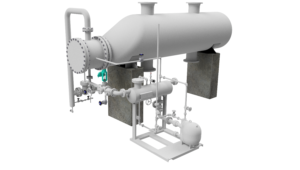James Risko - TLV Corporation
 Reboilers using an inlet steam control valve arrangement can provide significant economics and control benefits to certain distillation tower installations. By exposing the full surface area of a reboiler to steam for effective heat transfer, the steam pressure can be lowered – which can reduce the fouling that can occur with higher pressure steam and the corrosion that can occur with flooding a tube bundle. Control can improve because steam can adjust to process control demand changes much more rapidly than by the alternative of varying a liquid level – such as occurs with outlet valve control. Furthermore, it is generally not possible to lose the condensate seal/reboiler duty when the proper drainage design is implemented. Other potential benefits include mitigation of the stratification that can plague channel head gasketing in horizontal designs, and the use of “long” low pressure steam to improve the steam balance or reduce generation requirements.
Reboilers using an inlet steam control valve arrangement can provide significant economics and control benefits to certain distillation tower installations. By exposing the full surface area of a reboiler to steam for effective heat transfer, the steam pressure can be lowered – which can reduce the fouling that can occur with higher pressure steam and the corrosion that can occur with flooding a tube bundle. Control can improve because steam can adjust to process control demand changes much more rapidly than by the alternative of varying a liquid level – such as occurs with outlet valve control. Furthermore, it is generally not possible to lose the condensate seal/reboiler duty when the proper drainage design is implemented. Other potential benefits include mitigation of the stratification that can plague channel head gasketing in horizontal designs, and the use of “long” low pressure steam to improve the steam balance or reduce generation requirements.
However, in order to achieve those benefits, inlet steam control has to overcome certain potential operational pitfalls, which can create bottlenecks in the system drainage and hinder process operation. These include insufficient pressure to discharge condensate into the return header on start-up, under low demand, or when the tube bundle is relatively clean. Also, there can be design uncertainty relative to the drainage system utilized – steam trap (and if so, which type?), pump/trap, level pot, electric pump? Moreover, insufficient understanding of balance requirements for level pots or pump/trap reservoirs can lead to reboiler evacuation issues, such as stall, backup, hammer, and corrosion.
To help improve reboiler performance when using inlet steam control valve operation, this presentation reviews historical negative experiences and provides insight into design options to mitigate condensate backup in reboiler operation.
 JAMES R. RISKO, CEM, PEM, MBA is president of TLV Corporation, Charlotte, NC, responsible for US and Canadian operations. He has 44 years of steam systems experience, authored more than 60 technical articles, provided webinars to over 2,500 attendees globally, and presented at IETC, AIChE, and AFPM conferences. He co-invented the world’s first combination pump-traps and created the “Extended Stall Chart,” for draining stalled heat exchangers. He is active in FCI, ANSI, and ISO standards. An avid tennis player, he has three energy management certifications.
JAMES R. RISKO, CEM, PEM, MBA is president of TLV Corporation, Charlotte, NC, responsible for US and Canadian operations. He has 44 years of steam systems experience, authored more than 60 technical articles, provided webinars to over 2,500 attendees globally, and presented at IETC, AIChE, and AFPM conferences. He co-invented the world’s first combination pump-traps and created the “Extended Stall Chart,” for draining stalled heat exchangers. He is active in FCI, ANSI, and ISO standards. An avid tennis player, he has three energy management certifications.






